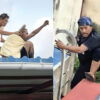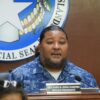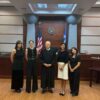Due to the Covid-19 pandemic, which delayed the opening of this academic year, PSS had to implement strict measures in compliance with the government’s public health emergency directives, he added,
These safety measures, which resulted in lower enrollment, prompted PSS to start the school year by conducting online classes and providing students with learning packets, Ada said in an interview.
Although face-to-face learning is allowed for early childhood education, only 10 or less students could be in a classroom during the first quarter of the school year or from Sept. 8 to Nov. 13, he added.
“We digitalized everything. All the curriculum. Our student support system worked on social emotional learning, which is character education because our kids are traumatized,” Ada said.
“We opened the school year on Sept. 8 with learning packets because parents did not want to bring their kids to school,” he said.
Ada said for the second quarter, which began on Nov. 17, PSS is increasing the number of elementary school students to 15 per classroom.
“Schools will reopen sooner if all of them are ready to implement face-to-face classes,” the commissioner said.

Education Commissioner Alfred B. Ada delivers his opening remarks during the Education Month awards presentation in the Marianas High School cafeteria on Monday. Photo by Emmanuel T. Erediano
Ada said he has also asked school principals to help the students who are struggling, including those with attendance problem in remote learning, and those participating in the individual education plan or IEP, which he designed for students with disabilities.
In the third quarter, which will begin on Feb. 3, PSS plans to implement blended learning for kindergarten and elementary school students, he said.
Kagman Elementary School and William S. Reyes Elementary School, for their part, are preparing to offer blended learning sooner than Feb. 3, he added.
Under blended learning, Ada said, students will be assigned to blue or green groups.
Each week, students will participate in two days of face-to-face learning, two days of remote learning and one day for class meetings, online activities and completion of assignments.
For example, those in the blue group will attend classes at school on Tuesday and Wednesday and participate in remote learning on Thursday and Friday.
Those in the green group will attend classes at school on Thursday and Friday and participate in remote learning on Tuesday and Wednesday.
Ada said Monday, which is a government austerity day, will be ideal for providing social and emotional support to students and school staffers; remediation/intervention as needed; and collaborative planning and professional development sessions.
As for sixth to 12th graders, Ada said they can attend remote learning classes four days of the week.
“A lot of middle school and high school students prefer remote learning — it is the safest for sure,” he added.











